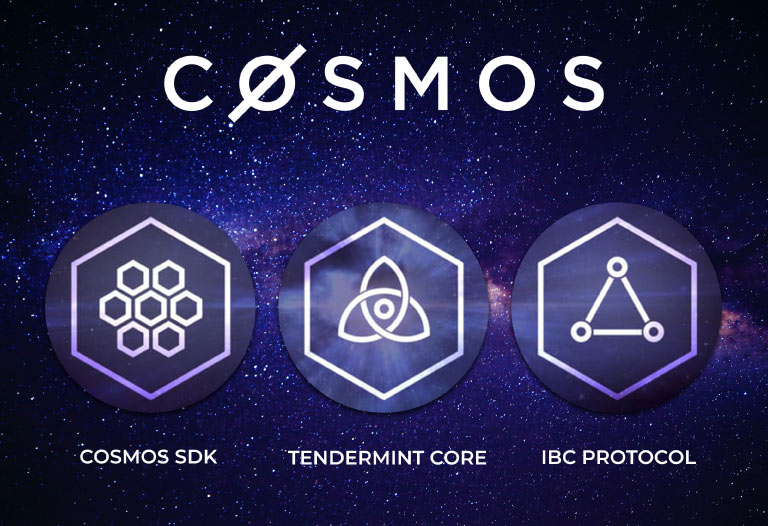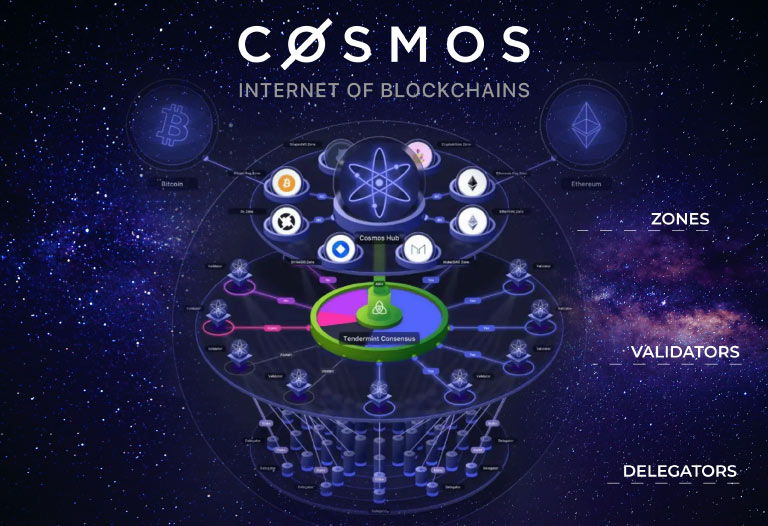
Table of Contents
ToggleInteroperability is one of the concepts that we have heard the most within the cryptocurrency ecosystem and is, in turn, one of the purposes that different projects, such as Polkadot, seek to achieve.
However, so far, within all the galaxies that make up the crypto universe, there is one in particular that has been characterized by its ability to exchange data and generate efficient and secure interactions between different cryptocurrency protocols and projects.
Today we will take a trip through space, visiting, as a destination, the Cosmos network.
In it, we will visualize all the stars and star clusters that make up the origin of Cosmos (ATOM) and its components.
What is Cosmos (ATOM)?
Cosmos (ATOM) is an open source, decentralized network of independent blockchains, each powered by Tendermint Core, a consensus BFT (Byzantine Fault Tolerance) protocol created by Tendermint.
Put another way, the Cosmos ecosystem is a blockchain system in which each block can scale and interoperate with each other.
Therefore, its main objective is to facilitate interoperability or, in simple words, communication between different applications and projects.
To this end, it makes blockchains powerful and easy to develop with Tendermint BFT and Cosmos’ modular SDK.
In addition to this, the Cosmos (ATOM) project has its own eponymous cryptocurrency, which is designed precisely to scale and interact with different blockchain, which uses a Proof of Stake (PoS) algorithm.
Honestly, it’s a definition full of concepts and history behind it, so let’s take it one step at a time.
The origin of Cosmos
First, let’s look at its history and what has happened to make Cosmos (ATOM) such a spectacular project today.
It all started in 2016, when in June, its creator Jae Kwon published his article about a project called Gnuclear.
The purpose of Gnuclear was to create an interoperable system for blockchain using the Tendermint consensus protocol, a company also founded by Jae Kwon.
By August, the project was renamed to Cosmos Project or Cosmos Network. Faced with the need for funds to carry out the process, in 2017, a private sale of a certain amount of ATOM was made at different prices (0.08 USD and 0.025 USD) resulting in a considerable sum of dollars.
Kwon, considering the results of the above, was encouraged to take out an ICO (Initial Coin Offering) of ATOM tokens at 0.1 USD, aiming to sell more than 160 million tokens. As a result, it collected USD 16 million.
Subsequently, in September of the same year, the first test of the ATOM token technology was carried out, where failures were found that led the team to review the operation of the system.
Finally, in 2019, the main Cosmos network was launched. It was there that the real work on its network began, after mining the first block of the network.

What are the components of Cosmos (ATOM)? Let’s talk about Tendermint Core, Cosmos SDK and IBC Protocol.
Tendermint Core
Tendermint is an algorithm created by Jaek Won in 2014, with the goal of providing a high security and high speed algorithm.
For this reason, based on the premise of Byzantine Fault Tolerance (BFT), it is composed by a set of validators that are responsible for confirming new blocks in the blockchain.
They also replicate, in a secure and consistent way, an application on many machines, which means that blocks of years can be executed in weeks.
In this way, the network is secured, transactions are validated and blocks are sent to the blockchain. For this purpose, it is connected between applications via the ACBI (Application Blockchain Interface) protocol.
Cosmos SDK
To create a secure ABCI from scratch is difficult. That’s why the Cosmos SDK exists.
The software development kit (SDK), allows developers to create blockchains based on Cosmos Hub.
In this development environment, the consensus manager is the Tendermint algorithm, which minimizes the complexity of the creation process.
To do so, it builds a set of basic modules that are necessary in the Cosmos Hub. This allows two things to happen:
- Developers can make use of these pre designed modules to avoid the hassle of thinking about building a blockchain from scratch.
- They can create complements and add any additional features they wish to have.
To this end, in its modules, it includes aspects that influence the functionality of blockchain networks, such as participation, governance, and so on.
Blockchain Communication Protocol (IBC Protocol)
The Cosmos IBC communication protocol (ATOM) is a mechanism that allows information and transactions to be transmitted freely and securely between each connected zone.
In that sense, it leverages Tendermint consensuses to allow heterogeneous chains to transfer tokens or data between each other.
Specifically, once a zone is connected to the Cosmos Hub, it is interoperable with all other connected zones, which means that blockchains with more different applications, validators and consensus mechanisms such as Ethereum, Bitcoin or even Cosmos (ATOM) can exchange data.

How does the Cosmos network structure work?
The Cosmos network consists of three layers: zones, validators and delegators.
Zones and hubs: Let’s talk about Cosmos Hub.
As opposed to the idea of connecting each blockchain in the network through direct IBC connections, the network zones are heterogeneous blockchains (e.g. cryptos such as Bitcoin, Dash, Tron, among others).
In contrast, Hubs, the center of the Cosmos structure, are blockchains specifically designed to connect the zones together.
Consequently, when a zone, such as Ethereum, creates a connection via the IBC communication protocol with a Hub, it can automatically send and receive data or tokens from another zone that is connected to it.
In this way, it is as if it were an Internet of Blockchains, where, whatever country you are from, you can find out the latest news from China or Mexico in seconds or make purchases and sales of items from other markets around the world.
In hubs, double spending between zones is avoided, that is, when a zone receives a token from a hub, it only needs to trust the zone of origin of this token and the hub, which, through its internal protocols and hashes, will avoid duplication or multiple use of cryptos.
The first Hub launched by Cosmos Network was Cosmos Hub, which is a public PoS (Proof of Stake) chain, whose native token is ATOM.
Validators
Effectively, the role of validators is to run a complete node and participate in the consensus by casting votes containing cryptographic signatures.
For example, if you were going on a trip to Italy, at the airport an official checks if you meet the conditions and requirements for travel, such as:
- Your papers are up to date.
- Your passport.
- Secure luggage, that is, without any illegal object or substance inside it.
- If the money you are going to travel with is allowed or must be declared for its amount.
Afterwards, they will tell you whether or not you can board.
Exactly this job would be done by validators: they check if all transactions are valid and in order and vote on whether it can be accepted or not.
Delegators
Delegators are ATOM holders who cannot run a validator themselves, so they delegate ATOMS to a validator and get a share of their income in return.
In other words, they are like the bosses of a company who, when they are short-staffed, take out vacancies to hire new people who can perform the actions that are not theirs to perform.
Delegators play a key role, as they are the human resources managers involved in the selection processes of validators in a hub.
Hence, after introducing them to the company, they should actively monitor their actions and participate in voting.
Oh! Attention, Houston! We have a problem. We got to the end of our article and we barely made it to the moon in the Cosmos (ATOM) galaxy, we couldn’t go any further.
For an upcoming takeoff to other galaxies, head over to our main blog, where you will find much more information about this enormous universe that we are just discovering in its entirety.
See you next time, Bitnauta!




